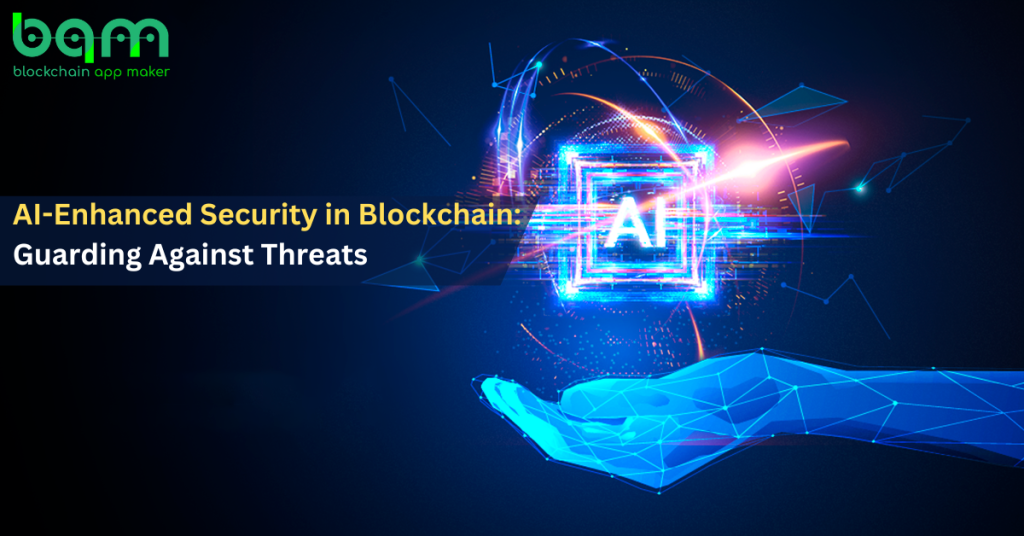
In the ever-evolving era of technology, the fusion of artificial intelligence (AI) and blockchain stands as a powerful alliance, poised to reshape the way we secure data and transactions. Security has always been a critical aspect of blockchain technology, underpinning its promise of trust and decentralization. As blockchain networks continue to grow and diversify, the need for robust security measures has never been more pronounced. AI, with its ability to analyze vast amounts of data in real time, has emerged as a game-changer in the realm of blockchain security. It proactively identifies and mitigates potential threats, offering a new level of protection against a wide range of risks. In this article, we will delve into the essential role of AI in fortifying blockchain security, exploring the core principles of blockchain security, AI’s proactive threat detection capabilities, real-world examples of AI in action, and the future trends and best practices that will shape the security landscape of blockchain networks. Join us on this journey to understand how AI is enhancing the security of the digital ledger technology that underpins the future of trusted transactions.
- Understanding Blockchain Security
Blockchain security is the bedrock of trust and reliability in the digital age. To comprehend the significance of safeguarding blockchain networks, it’s essential to grasp the fundamental principles that underlie their security.
At its core, blockchain security relies on decentralization, a principle that sets it apart from traditional centralized systems. The decentralized nature of blockchain means that data is distributed across a network of nodes, making it exceptionally resistant to single points of failure. To compromise the security of a blockchain, an attacker would need to gain control of a majority of the network, an extremely challenging feat.
However, this doesn’t mean blockchain is protected to threats. Several common threats and vulnerabilities persist, even within the strong structure of a blockchain network. These include 51% attacks, where a group of miners controls the majority of the network’s hashing power, and double-spending, where an individual attempts to spend the same cryptocurrency twice. These vulnerabilities can undermine the trust and integrity of blockchain systems. Given the potential risks, robust security measures are paramount in the world of blockchain. Encryptions and cryptographic techniques play a key role in ensuring data integrity, authentication, and authorization. In addition to these technical measures, best practices for user security, wallet protection, and secure smart contract development are also essential aspects of blockchain security.
As we delve deeper into the realm of blockchain security, it becomes evident that its strength lies not only in its foundational principles but in the strategic implementation of security measures that safeguard against common threats and vulnerabilities. In the sections that follow, we will explore how AI enhances this security landscape, providing proactive threat detection and mitigation.
2. The Synergy of AI and Blockchain Security
In the digital age, the combination of Artificial Intelligence (AI) and blockchain security forms a powerful alliance that elevates the protection of digital assets and transactions. Understanding how AI enhances blockchain security and its proactive threat detection capabilities provides insight into the remarkable synergy between these two technological marvels.
- How AI Enhances Blockchain Security: AI brings an extra layer of intelligence to the robust security framework of blockchain networks. Unlike traditional security measures that rely on predetermined rules, AI systems have the capability to analyze vast amounts of data in real-time. This dynamic analysis allows AI to adapt to emerging threats and vulnerabilities, making it an invaluable asset in the realm of blockchain security. AI’s adaptability enables it to respond to new attack vectors and adjust its defenses accordingly.
- AI’s Proactive Threat Detection Capabilities: AI’s proactive threat detection capabilities are a game-changer for blockchain security. By continuously monitoring network activity, AI can identify anomalies, irregularities, and potential security breaches before they can inflict damage. This real-time threat assessment empowers blockchain networks to respond swiftly and effectively, reducing the risk of successful attacks. AI’s ability to spot suspicious activities, such as unauthorized access attempts or fraudulent transactions, is a critical asset in maintaining the integrity of blockchain systems.
- Examples of AI in Blockchain Security: To illustrate the practical applications of AI in blockchain security, let’s explore a few compelling examples. Major blockchain platforms and financial institutions have harnessed AI’s capabilities to secure their networks. For instance, a prominent cryptocurrency exchange integrated AI-based security measures to detect and prevent fraudulent transactions. The AI system’s ability to analyze transaction patterns and identify suspicious behavior has saved millions of dollars in potential losses. Additionally, a leading blockchain consortium adopted AI for real-time monitoring of its member nodes, significantly enhancing the security of its decentralized network.
These examples demonstrate how AI actively contributes to the security of blockchain networks, providing concrete results in threat detection and prevention. The synergy between AI and blockchain security is shaping a future where digital transactions are more secure, strong, and trustworthy.
As we explore deeper into this dynamic partnership, we’ll explore the evolving trends and best practices that will define the security landscape of blockchain networks in the years to come.
3. AI for Threat Detection and Prevention
Artificial Intelligence (AI) has emerged as an invaluable ally in the ongoing battle to secure blockchain networks against threats and vulnerabilities. Its role in detecting and preventing these threats is nothing short of transformative.
- Detecting and Preventing Threats: AI’s contribution to blockchain security is multilayered. One of its key roles is the early detection of potential threats. AI-driven systems continuously analyze the huge amount of data generated on blockchain networks, identifying patterns and glitches that might signify a security breach or suspicious activity. Unlike traditional, rule-based security systems, AI has the ability to adapt and develop, making it a proactive guardian of blockchain integrity.
- Identifying Suspicious Activities: AI’s remarkable capacity to identify suspicious activities goes hand-in-hand with its threat detection capabilities. It can identify unusual transaction patterns, irregularities in data flow, and potential security breaches. By analyzing data in real-time, AI helps blockchain networks stay one step ahead of malicious actors, preventing potential damage before it occurs.
- Real-World Case Studies: To illustrate the real-world impact of AI in blockchain security, let’s examine a few compelling case studies. In recent years, major blockchain platforms and financial institutions have integrated AI-based security measures to fortify their networks. These cases showcase how AI has thwarted security breaches, identified fraudulent transactions, and maintained the integrity of blockchain systems. By delving into these examples, we gain a deeper understanding of how AI actively protects the blockchain ecosystem.
In one such case, an AI-powered system detected and thwarted a 51% attack on a major blockchain network. By identifying the anomaly in the network’s hashing power distribution, the AI system automatically initiated countermeasures, safeguarding the network’s integrity.
These case studies are just a glimpse of the immense potential AI holds in the realm of blockchain security. Its ability to adapt, learn, and evolve in response to emerging threats positions AI as an indispensable tool for safeguarding the future of trusted transactions.
As we explore the synergy between AI and blockchain security, it becomes evident that AI’s proactive threat detection and prevention capabilities are shaping a future where blockchain networks are more secure, resilient, and trustworthy than ever before. In the following section, we will delve into the evolving trends and best practices that will further define this dynamic landscape.
4. Future Trends and Best Practices
As the symbiotic relationship between Artificial Intelligence (AI) and blockchain security continues to evolve, it’s essential to stay informed about the emerging trends and best practices that will shape the future of secure digital transactions.
- Future Trends in AI-Enhanced Blockchain Security: The future of AI-enhanced blockchain security holds exciting prospects. AI is expected to become even more proficient at identifying and mitigating threats. Machine learning models will continue to improve, enabling quicker response times and more accurate threat assessments. Additionally, AI systems will likely become more accessible to a broader range of organizations, allowing even small and medium-sized enterprises to benefit from advanced security measures. As blockchain networks expand and diversify, AI will play a pivotal role in preserving the integrity and trustworthiness of these systems.
- Best Practices for Implementing AI Solutions: To make the most of AI-enhanced security, organizations and developers should adhere to best practices. It’s crucial to carefully select and implement AI solutions that align with the specific needs of a blockchain network. Regularly update and fine-tune AI algorithms to keep pace with evolving threats. Establish robust governance and access control measures to secure AI systems themselves, preventing potential vulnerabilities. Moreover, integrating AI should complement existing security protocols rather than replace them. Properly trained and informed staff is also essential to ensure the successful deployment of AI security measures.
- The Importance of Staying Updated: In the dynamic world of technology and security, staying updated is of paramount importance. Blockchain networks and AI security solutions are continually evolving, and new threats are constantly emerging. Regularly monitoring and updating security systems, AI models, and protocols are essential to maintain the integrity of blockchain networks. Being aware of the latest developments in AI and blockchain security is vital for staying ahead of potential risks and vulnerabilities.
Conclusion
In conclusion, the future of AI-enhanced blockchain security promises enhanced protection, increased accessibility, and the preservation of trust in digital transactions. By adhering to best practices and remaining vigilant, organizations can harness the full potential of AI to secure their blockchain networks effectively. As we move forward, the synergy between AI and blockchain security will continue to redefine the boundaries of secure and trusted transactions.
In our exploration of the AI and blockchain security partnership, we’ve learned several critical points. Blockchain security is paramount for digital trust, though it faces its own set of vulnerabilities. AI bolsters this security, offering real-time threat detection and proactive defense. Real-world examples demonstrate AI’s practical utility in safeguarding blockchain systems.
The significance of AI in blockchain security cannot be overstated. It actively counters threats, adapts to emerging risks, and maintains network integrity. As we look ahead, the adoption of AI isn’t just recommended; it’s imperative. Embracing AI is essential for securing blockchain networks, ensuring the trust and reliability of digital transactions. This union between AI and blockchain security propels us into a future where security is synonymous with trust and dependability in the digital realm. It’s a journey we must collectively embark on as we navigate the ever-evolving digital landscape.

